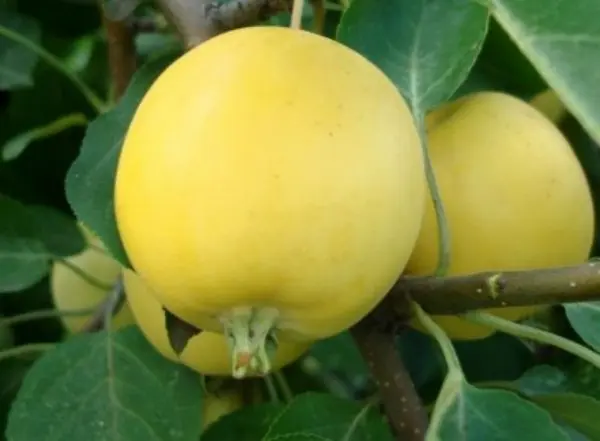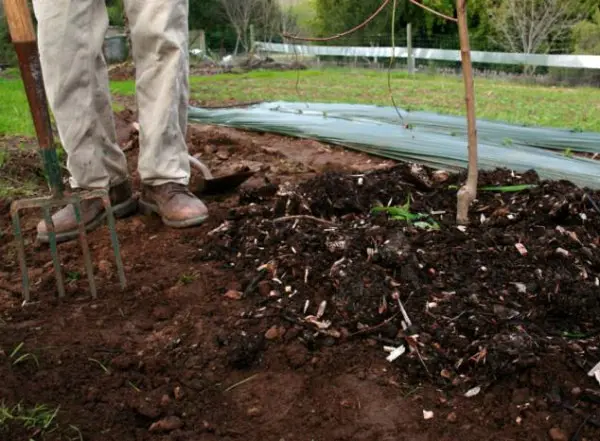Contents
There are quite a few varieties of apple trees adapted for growing in cold regions, but sometimes it is very difficult to choose one or even several species. Some withstand low temperatures well, but do not differ in the size of the fruits, while others, on the contrary, with large fruits, but require special care. The topic of this article will be the Ural bulk apple tree, which quite successfully combines the key qualities of winter-hardy species.
Description and characteristics
“Ural bulk” is an autumn variety apple tree, with medium-sized trees, especially if they are grafted. The description of the variety should begin with the fact that among the relatives, “Ural Bulk” is one of the first to bud and spread leaves.
The crown of the trees is round, drooping, becoming very dense over the years, so it needs to be thinned out. The branches are thin, elastic, with a light gray-green bark. Skeletal branches grow at right angles from the trunk, often in the first year they form many branches. Fruiting is concentrated equally on both fruit twigs and spears. Shoots of medium thickness, covered with light green bark with a brown tint. The leaves of the variety are elongated, light green, small-crested along the edges, practically without pubescence. Medium-sized apple trees bloom with pink flowers. The flowers are shaped like small bowls, without pubescence, the stigmas of the pistils are on the same level as the anthers.

Medium-sized apples, weighing about 60 grams in the first half of the life of an apple tree, but over time, their weight decreases to about 40 grams. The fruits are round, one-dimensional, their ribbing is not very pronounced. The peel of apples of this variety is green with a yellow tint, but with the onset of maturity it becomes a rich yellow color. On the side facing the sun, a blurred blush of light pink color is formed. The flesh is pale yellow, very juicy, with a persistent strong aroma. The taste of apples of this variety is sweet with almost imperceptible sourness.
For 100 grams of apple pulp, there are:
- 11% sugar;
- 14% dry matter;
- 9 mg of ascorbic acid;
- 0,6% titratable acids;
- 100 mg of P-active substances.

The fruits ripen by mid-September, however, the variety has several stages of ripening, depending on the method of application and processing. In early September, apples are harvested to make compotes and juices, since the density of the pulp is very high. In mid-late September, apples become suitable for fresh consumption, as the pulp becomes moderately soft and extremely juicy. And finally, apples harvested in October are good to use as a filling for baking or making jam, marmalade or jams.
A distinctive feature of the Ural bulk variety is that even overripe apples do not fall off the branches. The shelf life of apples harvested in mid-September is 2-2,5 months.
The variety is early-growing, the first crop can be harvested already in the 2nd year of cultivation. From year to year, the amount of harvest increases, despite the fact that the size of apples decreases somewhat. At the peak of development, up to 250 kilograms can be collected from one tree. Another positive characteristic feature of the variety is high winter hardiness.

History of breeding
“Ural bulk” was bred at the South Ural Research Institute of Horticulture after crossing the varieties “Ranetka Krasnaya” and “Papirovka”. The authorship of the variety belongs to the Chelyabinsk breeder P. A. Zhavoronkov. Exceptional winter hardiness has made the variety extremely popular in the North-Western regions of Our Country.
The peak of popularity of “Ural Bulk” was in the 1970s, the gardeners really fell in love with the variety. It is not surprising, because in addition to winter hardiness, apple trees adapt well to almost any conditions and types of soil.
Planting and care
The landing description should begin with the landing site selection criteria. The place should be bright, if possible protected from strong winds. The fact is that often the branches of trees do not withstand the load of ripening fruits and crack – a strong wind can speed up the process.
Although the variety does not have a special preference for the type of soil, it is still not worth planting apple trees in acidic soils. It is best to plant seedlings in fertile soil rich in nitrogen, especially if the groundwater does not lie close to the surface.

Apple seedling planting technology
A week and a half before planting, you need to start preparing the pits. The depth of the pit should be about 90 centimeters, while the width must be determined by the span of the roots. The bottom is lined with a mixture of the top layer of soil, humus, superphosphate and ammonium nitrate. Before planting, the roots of the seedling must be straightened, trying not to damage them, and then set the seedling in the hole and tie it to the support peg. The pit must be carefully covered with earth, periodically tamping. Water the seedling thoroughly afterwards.
The description of the care for the Ural Bulk variety is not much different from the care for other types of winter-hardy apple trees. Every spring it is necessary to cut off old or dried branches to protect the plant from diseases. It is important to whitewash the trunks with garden lime, as well as treat them with fungicides and insecticides.
It is important to fertilize regularly, especially during the first years of tree growth. Nitrogen, phosphorus, potash fertilizers are most suitable for apple trees. Frequent watering is also important in the early years.

For the winter, the trunk circle of apple trees should be mulched with sawdust, peat or straw. If weather forecasters are predicting a very cold winter, you can also wrap tree trunks with covering material to protect them from frost.
Fighting diseases and pests
The description in the catalog of fruit trees states that the Ural bulk variety is moderately resistant to almost all fungal diseases. Among the most dangerous diseases are powdery mildew, scab and fruit rot. Symptoms of diseases appear on all parts of the tree, and pathogenic spores can overwinter not only in fallen leaves, but also in the folds of the bark or the upper layers of the soil. As a prevention of fungal diseases, it is necessary to spray twice a year with fungicides of complex action, for example, “Fitosporin” (read the description of the application on the package), and in the spring water the trees with a solution of urea.

Among insects, the most dangerous are the red aphid and the codling moth. Corrugated paper traps can be used against them, as well as chemicals, for example, Karbofos. As a preventive measure, it is necessary to cut off the old bark from the trees, regularly clean off the fallen leaves.
Video “Apple trees for Siberia”
This video tells about the apple trees of the Ural selection, which feel great in the harsh conditions of Siberia.









